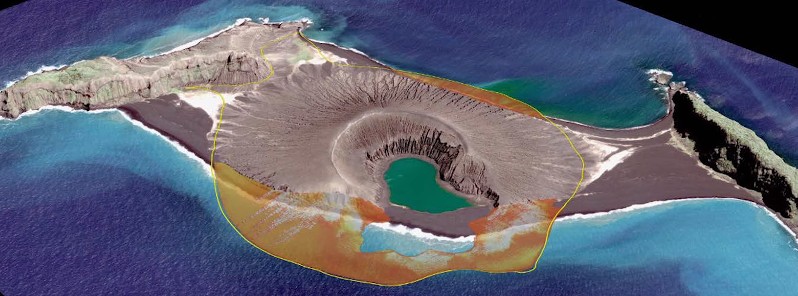New timelapse of Hunga Tonga-Hunga Ha’apai volcanic island forming

In December 2014 and early 2015, Hunga Tonga-Hunga Haʻapai undersea volcano near Tonga's capital Nuku'alofa erupted, sending a violent stream of steam, ash and rock into the air. When the ash finally settled in January 2015, a newborn island with a 120 m (400 feet) summit nestled between two older islands – visible to satellites in space. The newly formed Tongan island, unofficially known as Hunga Tonga-Hunga Ha'apai, was initially projected to last a few months. Now it has a 6- to 30-year lease on life, according to a new NASA study.
Hunga Tonga-Hunga Ha'apai is the first island of this type to erupt and persist in the modern satellite era, giving scientists an unprecedented view from space of its early life and evolution. It is also the third 'surtseyan' volcanic island in the last 150 years to emerge and persist for more than a few months. Surtsey is an island that began forming during a similar kind of explosive, marine eruption off the coast of Iceland in 1963.
From the Tongan island’s beginning, it was tracked by monthly, high-resolution satellite observations, both with optical sensors and radar, which sees through clouds. Alerted to the volcanic eruption by NASA's Rapid Response program for the Moderate Resolution Imaging Spectroradiometer (MODIS) instruments, Garvin and his colleagues directed satellites to observe the island as soon as the eruption ended. Using this imagery, the research team made three-dimensional maps of the island’s topography and studied its changing coastlines and volume above sea level.
The most dramatic changes to the island occurred in its first six months. Initially, the new island was relatively oval and attached to its neighboring island to the west. However, by April analysis of satellite imagery found that its shape had changed dramatically.

"Volcanic islands are some of the simplest landforms to make," said first author of the new study Jim Garvin, chief scientist of NASA's Goddard Space Flight Center. "Our interest is to calculate how much the 3D landscape changes over time, particularly its volume, which has only been measured a few times at other such islands. It's the first step to understand erosion rates and processes and to decipher why it has persisted longer than most people expected."
"There’s a huge amount of material that came out from this eruption, possibly larger than at Surtsey," said geologist and co-author Vicki Ferrini. "The other interesting thing is that the two islands that surround this new land mass have some pretty tough substrate, so there’s something happening to help make this solidify and stay in place, chemically."


The 54-year old Surtsey island near Iceland survived past its first few months because warmed seawater interacted with ash after the eruption, chemically altering the fragile and easily eroded rock into a tougher material. Garvin and Ferrini believe something similar may have occurred with this new island. Their next step is a detailed chemical analysis of rock samples.
Featured image copyright: DigitalGlobe

More than 10 new islands formed in the last 20 years. This is clear evidence for the increase of undersea volcanic eruptions. But, of course mainstream science does not want to mention this fact, because the business of climate change will be in trouble
Your comment is a fabricated pile of rubbish. There is no “clear evidence” of any increase of submarine volcano eruptions, nor is “mainstream science” hiding anything about the effect they have on climate change. Perhaps you need to learn how to use the internet better, because you seem to prefer to make up stories rather than educate yourself on the topic.
Thank you, Roger West. The content on The Watchers seems to be firmly grounded in objective science reporting. The comments section, however, is infested with conspiracists and armageddon fetishists.